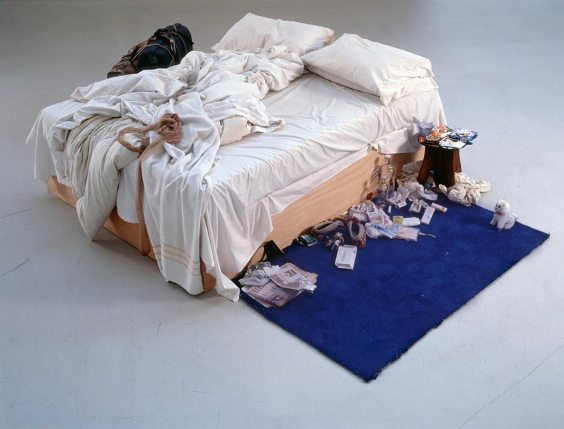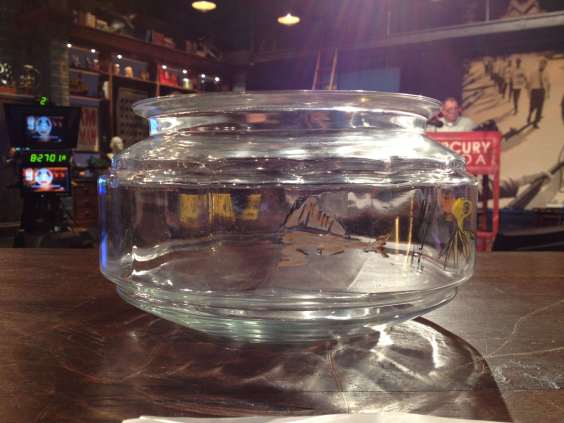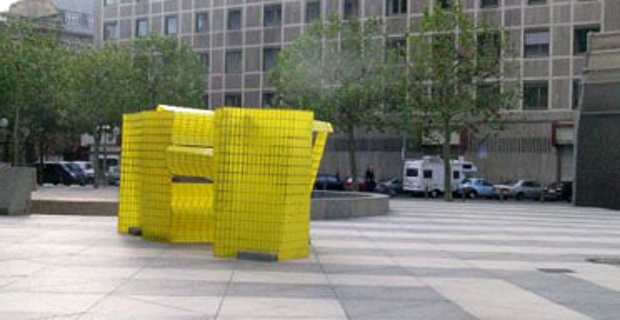It’s contemporary art’s job to ask questions: to test the boundaries of what constitutes art, to see value in the aspects of everyday life that most people overlook; to throw out the rulebook. But if you create art out of rubbish – as as surprising number of people do these days – then every now and then someone is going to throw that out too. Each of these artists have seen their artworks and installations meet messy (or rather, very tidy) ends at the hands of the people tasked with keeping galleries and public spaces clean.
Gustav Metzger
Gustav Metzger pioneered Auto-Destructive art in 1960 with a public demonstration at Temple Gallery in London. His concept of ‘paintings, sculptures and constructions having a finite existence – after which they will be destroyed’ was highly influential, so when Tate Britain staged ‘Art and the Sixties’ in 2004 he was invited to remake the piece, which included a transparent bin bag stuffed with waste paper. The night before the show’s opening, a cleaner unwittingly sped up the destructive process by throwing Metzger’s Recreation of First Public Demonstration of Auto-Destructive Art in a skip.
Damien Hirst
‘As soon as I clapped eyes on it I sighed because there was so much mess’, said Emmanuel Asare, the man responsible for bagging up and binning a new installation by Damien Hirst at Eyestorm Gallery in 2001. Hirst had created the piece, which included old ashtrays, newspapers and used coffee cups, as an evocation of an artist’s studio. Perhaps he should have sent Mr Asare round to his workplace, too.
Joseph Beuys
In 1943 Beuys’ crashed his Luftwaffe bomber into the Crimean mountains, where local Tatars found him and kept him warm by wrapping him in felt and grease. His subsequent use of those materials in his work was, therefore, highly symbolic to those who knew the backstory. But in 1986, an employee of the Academy of Fine Art in Düsseldorf took a more prosaic view of his grease-lined bathtub, helpfully scrubbing it clean.
Tracey Emin
Emin’s bed is one of the most famously messy artworks in the world, and one of her most controversial creations. Reactions to the 1998 have been mixed, to say the least. One woman tried to clear up the piles of rubbish and old clothes that litter the sheets. In 1998 two artists, Cai Yuan and Jian Jun Xi, decided to have a pillow fight instead, messing it up even more.

My Bed (1998), Tracey Emin © Tracey Emin
Orson Welles
American TV personality Glenn Beck was delighted to get his hands on Orson Welles’ fishbowl at auction in 1992. The unassuming bowl had been hand-painted and signed by the actor, and took pride of place in the new owner’s house – until one of his staff took it upon herself to wash it up. He took it quite well, remarking, ‘Let this be a lesson to me of not leaving dirty things on my desk’.

Orson Welles’ fishbowl after its wash. Source: http://www.glennbeck.com/
Jim Osman
New-York based artist Jim Osman spent weeks crafting his contoured, turf-topped bench, and drew on the example of lauded artists and architects including Le Corbusier. None of which saved his contribution to Madison’s Sculpture Mile this year, which was dismantled by an employee of the real estate company, the Ciminelli Real Estate Corporation, who thought it had been left behind by skateboarders.

Osman’s work was installed in a public plaza in Madison Source: https://nyoobserver.files.wordpress.com/2015/06/the-corbu-bench.jpg
Michael Beutler
In 2005, a public sculpture by German artist Michael Beutler met a similar fate to Osman’s. His large construction of yellow plastic sheeting was dismantled by one of Frankfurt’s dustmen. ‘I didn’t recognise it as art and there was no sign or anything to show it was art,’ said Peter Postleb after his mistake came to light, proving once again that when it comes to contemporary art, context is everything.

Michael Beutler’s work was mistaken for rubbish in Frankfurt Source: www.theguardian.com/world/2005/jan/13/arts.germany
Related Articles
Rubbished: contemporary art thrown away by cleaner (Maggie Gray)
Lead image: used under Creative Commons licence (CC BY-SA 2.0)

Trashing contemporary art
Is contemporary art rubbish? Photo: c_ambler/Flickr
Share
It’s contemporary art’s job to ask questions: to test the boundaries of what constitutes art, to see value in the aspects of everyday life that most people overlook; to throw out the rulebook. But if you create art out of rubbish – as as surprising number of people do these days – then every now and then someone is going to throw that out too. Each of these artists have seen their artworks and installations meet messy (or rather, very tidy) ends at the hands of the people tasked with keeping galleries and public spaces clean.
Gustav Metzger
Gustav Metzger pioneered Auto-Destructive art in 1960 with a public demonstration at Temple Gallery in London. His concept of ‘paintings, sculptures and constructions having a finite existence – after which they will be destroyed’ was highly influential, so when Tate Britain staged ‘Art and the Sixties’ in 2004 he was invited to remake the piece, which included a transparent bin bag stuffed with waste paper. The night before the show’s opening, a cleaner unwittingly sped up the destructive process by throwing Metzger’s Recreation of First Public Demonstration of Auto-Destructive Art in a skip.
Damien Hirst
‘As soon as I clapped eyes on it I sighed because there was so much mess’, said Emmanuel Asare, the man responsible for bagging up and binning a new installation by Damien Hirst at Eyestorm Gallery in 2001. Hirst had created the piece, which included old ashtrays, newspapers and used coffee cups, as an evocation of an artist’s studio. Perhaps he should have sent Mr Asare round to his workplace, too.
Joseph Beuys
In 1943 Beuys’ crashed his Luftwaffe bomber into the Crimean mountains, where local Tatars found him and kept him warm by wrapping him in felt and grease. His subsequent use of those materials in his work was, therefore, highly symbolic to those who knew the backstory. But in 1986, an employee of the Academy of Fine Art in Düsseldorf took a more prosaic view of his grease-lined bathtub, helpfully scrubbing it clean.
Tracey Emin
Emin’s bed is one of the most famously messy artworks in the world, and one of her most controversial creations. Reactions to the 1998 have been mixed, to say the least. One woman tried to clear up the piles of rubbish and old clothes that litter the sheets. In 1998 two artists, Cai Yuan and Jian Jun Xi, decided to have a pillow fight instead, messing it up even more.
My Bed (1998), Tracey Emin © Tracey Emin
Orson Welles
American TV personality Glenn Beck was delighted to get his hands on Orson Welles’ fishbowl at auction in 1992. The unassuming bowl had been hand-painted and signed by the actor, and took pride of place in the new owner’s house – until one of his staff took it upon herself to wash it up. He took it quite well, remarking, ‘Let this be a lesson to me of not leaving dirty things on my desk’.
Orson Welles’ fishbowl after its wash. Source: http://www.glennbeck.com/
Jim Osman
New-York based artist Jim Osman spent weeks crafting his contoured, turf-topped bench, and drew on the example of lauded artists and architects including Le Corbusier. None of which saved his contribution to Madison’s Sculpture Mile this year, which was dismantled by an employee of the real estate company, the Ciminelli Real Estate Corporation, who thought it had been left behind by skateboarders.
Osman’s work was installed in a public plaza in Madison Source: https://nyoobserver.files.wordpress.com/2015/06/the-corbu-bench.jpg
Michael Beutler
In 2005, a public sculpture by German artist Michael Beutler met a similar fate to Osman’s. His large construction of yellow plastic sheeting was dismantled by one of Frankfurt’s dustmen. ‘I didn’t recognise it as art and there was no sign or anything to show it was art,’ said Peter Postleb after his mistake came to light, proving once again that when it comes to contemporary art, context is everything.
Michael Beutler’s work was mistaken for rubbish in Frankfurt Source: www.theguardian.com/world/2005/jan/13/arts.germany
Related Articles
Rubbished: contemporary art thrown away by cleaner (Maggie Gray)
Lead image: used under Creative Commons licence (CC BY-SA 2.0)
Unlimited access from just $16 every 3 months
Subscribe to get unlimited and exclusive access to the top art stories, interviews and exhibition reviews.
Share
Recommended for you
Rubbished: contemporary art thrown away by cleaner
The two works, part of a group display in Italy, were mistaken for rubbish
Florida artist destroys Ai Weiwei vase
A Florida artist has been charged with destroying a vase by Ai Weiwei in an apparently deliberate attack
Hans Ulrich Obrist & The Poetry of Rubbish
Mistaking art for rubbish is a grand tradition. But so is mistaking rubbish for art…